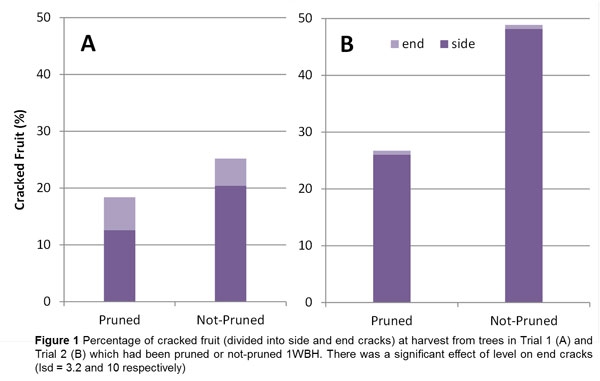Extension growth in cherries (current season leaf growth) occurs throughout the fruit growing season and can be a contributing source of sugars. However, while growing actively they can also require a lot of sugar for their own growth. Hence the question, to cut or not to cut?
Summer pruning can be used to reduce vigour or promote light interception. Can it also be used to reduce competition for sugars between growing fruit and extension growth? And what is the role of extension growth on fruit quality?
The role of extension growth
This study investigated the role of extension growth to current season fruit quality, and any affect on buds the following season.
To achieve this, leaf (and therefore leaf-supplied water) was removed at different times in relation to both climate and stage of fruit growth.
Also, given that movement of water into the fruit can be related to fruit cracking; cracking levels were closely monitored to see if strategic removal of extension growth contributed to any reductions in cracking.
Trial
Varieties Sweetheart, and Satonishiki were used in five trials in southern Tasmania.
Extension growth was removed at various growth stages throughout the summer, and in two trials, removal occurred during a rainfall event to see if water distribution in the tree was changed.
At harvest, mature fruit were sorted into side-cracked, end-cracked (apical and stem-end) and non-cracked fruit; and fruit was further assessed for quality parameters (size, weight, firmness, sugars and acidity).
Developing buds were collected during the summer period (early February) soon after harvest, and more were collected during the dormant period. Buds were analysed for starch and sugar content.
Uniformity of bud burst (assessed as ‘side green’) in the following spring was calculated by visually assessing each bud on two-year old wood samples. Uniformity of fruit the following season was also assessed.
Results
Cracking
Removal of extension growth during rainfall shortly before harvest significantly decreased total and side cracks in Sweetheart.
Cracking was reduced by nearly 50% in one site (Figure 1).
In each of these trials approximately 11 mm of rainfall occurred in one event.
In another trial using Sweetheart, there was no reduction on cracking when removal of extension growth occurred prior to a rainfall event shortly before harvest.
The timing of removal had an impact on the level of cracking. A significant difference in side cracks was found between times—removal during Stage II of fruit development increased cracking levels at harvest in Sweetheart.
In this trial, rainfall occurred a few days before harvest. However, removal of extension growth during Stage III—about a week before harvest—decreased cracking levels found at harvest (Figure 2).
No difference in cracking levels was found with removal of extension growth in Satonishiki, but there was an impact on fruit quality.
Sugars
Continued next issue
See the article an graphs in Tree Fruit August 2013






















